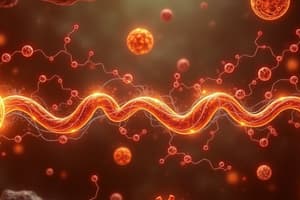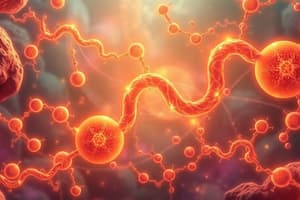Podcast
Questions and Answers
What is the primary pathway for triglyceride synthesis in most cells?
What is the primary pathway for triglyceride synthesis in most cells?
- Fatty acid synthesis pathway
- Monoacylglycerol pathway
- Kennedy pathway (correct)
- Cholesterol synthesis pathway
Which enzymes are responsible for catalyzing the final step in triglyceride synthesis?
Which enzymes are responsible for catalyzing the final step in triglyceride synthesis?
- DGAT enzymes (correct)
- LPL enzymes
- MGAT enzymes
- ACAT enzymes
In which cellular compartment is triacylglycerol predominantly synthesized in eukaryotes?
In which cellular compartment is triacylglycerol predominantly synthesized in eukaryotes?
- Mitochondria
- Endoplasmic reticulum (correct)
- Golgi apparatus
- Nucleus
What type of lipids do MGAT enzymes primarily act upon?
What type of lipids do MGAT enzymes primarily act upon?
Which pathway is involved in recycling lipids in specific cell types such as intestinal enterocytes?
Which pathway is involved in recycling lipids in specific cell types such as intestinal enterocytes?
What are lipid droplets primarily used for within cells?
What are lipid droplets primarily used for within cells?
Which of the following is NOT involved in triglyceride synthesis?
Which of the following is NOT involved in triglyceride synthesis?
What type of lipids cannot dissolve in water due to their neutral charge?
What type of lipids cannot dissolve in water due to their neutral charge?
Where does fatty acid synthesis primarily occur in the cell?
Where does fatty acid synthesis primarily occur in the cell?
What is the rate limiting step in fatty acid synthesis?
What is the rate limiting step in fatty acid synthesis?
What stimulates fatty acid synthesis after a carbohydrate-rich meal?
What stimulates fatty acid synthesis after a carbohydrate-rich meal?
Which enzyme complex is primarily responsible for fatty acid synthesis?
Which enzyme complex is primarily responsible for fatty acid synthesis?
Which pathway is responsible for transporting acetyl-CoA from the mitochondria to the cytoplasm?
Which pathway is responsible for transporting acetyl-CoA from the mitochondria to the cytoplasm?
Which type of enzymes are involved in the biosynthesis of triglycerides?
Which type of enzymes are involved in the biosynthesis of triglycerides?
What form of acetyl-CoA is primarily used in the cytoplasm for fatty acid synthesis?
What form of acetyl-CoA is primarily used in the cytoplasm for fatty acid synthesis?
What is the primary function of lipid droplets within cells?
What is the primary function of lipid droplets within cells?
What is the role of acetyl-CoA carboxylase (ACC) in fatty acid synthesis?
What is the role of acetyl-CoA carboxylase (ACC) in fatty acid synthesis?
How is AMP kinase (AMPK) related to the function of acetyl-CoA carboxylase (ACC)?
How is AMP kinase (AMPK) related to the function of acetyl-CoA carboxylase (ACC)?
What happens to the AMP/ATP ratio when glucose levels are high?
What happens to the AMP/ATP ratio when glucose levels are high?
In the process of energy generation, which statement is correct about ATP and ADP?
In the process of energy generation, which statement is correct about ATP and ADP?
What is the primary chemical responsibility for
What is the primary chemical responsibility for
How does a high carbohydrate meal affect fatty acid synthesis?
How does a high carbohydrate meal affect fatty acid synthesis?
What is typically observed when there is a rise in the ADP:ATP ratio?
What is typically observed when there is a rise in the ADP:ATP ratio?
Which statement is true regarding the relative concentrations of ADP and AMP during energy stress?
Which statement is true regarding the relative concentrations of ADP and AMP during energy stress?
What distinguishes microvesicular steatosis from macrovesicular steatosis in hepatocytes?
What distinguishes microvesicular steatosis from macrovesicular steatosis in hepatocytes?
During the fed state, what role does insulin play in glucose homeostasis?
During the fed state, what role does insulin play in glucose homeostasis?
Which statement best describes the effect of glucagon in the fasting state?
Which statement best describes the effect of glucagon in the fasting state?
What is the primary function of glycogen in muscle cells?
What is the primary function of glycogen in muscle cells?
What is typically seen in histological analysis of hepatocytes with macrovesicular steatosis?
What is typically seen in histological analysis of hepatocytes with macrovesicular steatosis?
What happens to glycogen granules when an organism is in a fasting state?
What happens to glycogen granules when an organism is in a fasting state?
What is the consequence of a deletion of glucose-6-phosphatase?
What is the consequence of a deletion of glucose-6-phosphatase?
What role does dietary carbohydrate have in VLDL production?
What role does dietary carbohydrate have in VLDL production?
Flashcards are hidden until you start studying
Study Notes
Fatty Acid Synthesis
- High carbohydrate intake induces the production of citrate and acetyl-CoA in the cytosol, stimulating insulin secretion and fatty acid synthesis.
- Acetyl-CoA carboxylase (ACC) is the rate-limiting enzyme in fatty acid synthesis.
- ACC is inhibited by AMPK, which phosphorylates ACC, reducing its activity.
- AMPK is inactive in the presence of insulin.
- AMPK is activated when the AMP/ADP ratio is high.
AMP/ATP Ratio
- The AMP/ATP ratio increases when glucose levels are high and decreases when glucose levels are low.
Palmitic Acid Synthesis
- Fatty acid synthesis begins with the formation of palmitic acid (C16) from acetyl-CoA and malonyl-CoA.
- Malonyl-CoA is a three-carbon molecule derived from acetyl-CoA.
- Fatty acid synthesis occurs in the cytoplasm.
Fatty Acid Synthase System
- The fatty acid synthase system comprises seven enzymes linked together with an acyl carrier protein (ACP).
- The system is located in the cytoplasm.
- Acetyl-CoA for cytosolic fatty acid synthesis is derived from the mitochondrial acetyl-CoA via a citrate-malate shuttle.
Triglyceride Biosynthesis
- Triglyceride biosynthesis involves several enzymes, including glycerol kinase (GK), glycerol-3-phosphate acyl-transferase (GPAT), lysophosphatidic acid acyl-transferase (LPAAT), phosphotidic acid phosphohydrolase (PP), and diacylglycerol acyl-transferase (DGAT).
Lipid Droplets
- Lipid droplets are organelles responsible for storing lipids, primarily cholesterol esters and triglycerides.
- Lipid droplets bud from the ER, forming separate organelles for long-term lipid storage.
- DGAT enzymes catalyze the final step in triglyceride synthesis within the ER.
- ACAT enzymes, which synthesize cholesterol esters, are found in the ER and store the esters in lipid droplets.
De Novo Glycerolipid Synthesis
- This pathway, also known as the Kennedy pathway, is the primary route for triglyceride synthesis in most cells.
- It uses glycerolphosphate and fatty acyl-CoA to produce glycerolipids, including glycerophospholipids and triglycerides.
Monoacylglycerol Pathway
- This pathway is present in specific cell types like intestinal enterocytes and adipocytes.
- It recycles mono- and diacylglycerols back to triglycerides via reesterification.
- Monoacylglycerol acyltransferase (MGAT) enzymes 1-3 are crucial in this pathway.
Histological Analysis of the Liver
- Liver tissue often demonstrates lipid droplets of varying sizes.
- Microvesicular steatosis involves abnormal lipid accumulation within hepatocytes, preserving cellular architecture.
- Macrovesicular steatosis is characterized by a single large droplet that displaces the nucleus.
Dietary Carbohydrates and VLDL Production
- Increased dietary carbohydrate intake stimulates VLDL (very-low-density lipoprotein) production.
Insulin
- Insulin is a hormone that regulates glucose homeostasis.
Glucose Homeostasis
- Glucose homeostasis is maintained by the interplay of insulin and glucagon.
Glycogen
- Glycogen is stored as granules in cells, with their size fluctuating according to the organism's nutritional state.
- Insulin regulates the growth of glycogen granules during the fed state.
- Glucagon promotes the shrinkage of glycogen granules during the fasting state.
- Liver glycogen serves as a glucose source for gluconeogenesis.
- Muscle glycogen provides a source of energy for internal ATP synthesis.
Glucose-6-Phosphatase Deletion
- Deficiencies in the enzyme glucose-6-phosphatase can lead to glycogen storage diseases, affecting glucose homeostasis.
Studying That Suits You
Use AI to generate personalized quizzes and flashcards to suit your learning preferences.



